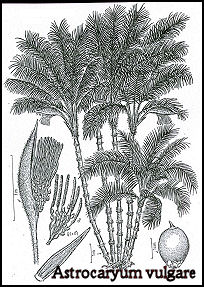ASTROCARYUM VULGARE - AWARA.
 Common names
Common names
Awarra, awara, tecuma, aiara, tecum, aoeara, murumuru, cumari, palmier tucaman, fiber palm.
Family
Arecaeae (Palmae).
Overview
Awara is one of the medium tall palms from the Amazon rainforest, growing up to
50 feet tall. This tree is common in the savannas and lowlands of Suriname.
The trunk is heavily spined and even the inflorescences are covered by a thorny spathe.
The Awara fruits grow in bunches of about 11 feet long on the tree; the weight of a single bunch is about 100 pound.
The orange-yellow fruit (about the size of a chicken egg) is an excellent source of carotenoids with a very
high concentration of ß-carotene (precursor of vitamin A).
It is also an important source of vitamin B2 (riboflavin).
The oil extracted from the pulp contains saturated fatty acids and unsaturated fatty acids. It is rich in Omega 3,
6 and 9. Since it is a good moisturizer it is used in cosmetics in skin moisturizers, lotions, and products for
damaged hair.
The fruit contains edible oil with a vitamin A content of 50,000 i.u. per 100 grams of pulp; this is 3 times higher
than that of carrot!
Due to this fact, Awara can be utilized against the eye disease xerophthalmia (also
called ophthalmoxerosis) of which the deficiency of vitamin A is the main reason.
This is a severe eye disorder, which results from night blindness; it causes closure of the cornea and ultimately
rupturing of eyes.
The fruit also contains in addition, carbohydrate, protein and fat.
The hard black seed is round and contains a
hard white substance from which a fine edible fat can be extracted.
These seeds can take more than a year to germinate!
From the leaves of the plant a fiber is extracted and used to make hammocks and baskets. This fiber is resistant to
rot and damage and was therefore in use on sail- ships in the earlier centuries.
In Suriname’s Traditional Medicine, awara is used for skin applications.
It helps to hydrate the skin and to soothe the scalp and also gives a natural gloss to damaged hair.
Hardiness
USDA zone 9b - 11.
Propagation
Seeds.
Culture
Full sun; sandy loam to dry soil.
Protect from frost.
|

